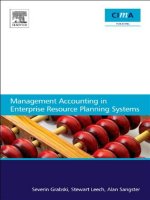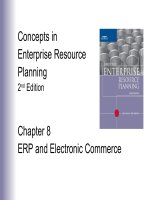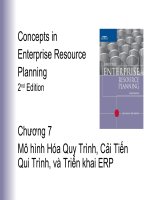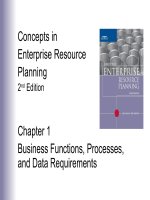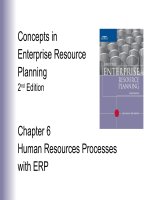Concepts in enterprise resource planning 4th development of ERP system ch02
Bạn đang xem bản rút gọn của tài liệu. Xem và tải ngay bản đầy đủ của tài liệu tại đây (290.92 KB, 47 trang )
Concepts in Enterprise
Resource Planning
Fourth Edition
Chapter Two
The Development of Enterprise
Resource Planning Systems
Objectives
After completing this chapter, you will be able to:
• Identify the factors that led to the development of
Enterprise Resource Planning (ERP) systems
• Describe the distinguishing modular characteristics
of ERP software
• Discuss the pros and cons of implementing an ERP
system
• Summarize ongoing developments in ERP
Concepts in Enterprise Resource Planning, Fourth Edition
2
Introduction
• Efficient, integrated information systems are very
important for companies to be competitive
• An Enterprise Resource Planning (ERP) system
can help integrate a company’s operations
– Acts as a company-wide computing environment
– Includes a database that is shared by all functional
areas
– Can deliver consistent data across all business
functions in real time
Concepts in Enterprise Resource Planning, Fourth Edition
3
The Evolution of Information Systems
• Silos
– Information systems configuration used until recently
– Companies had unintegrated information systems
that supported only the activities of individual
business functional areas
• Current ERP systems evolved as a result of:
– Advancement of hardware and software technology
– Development of a vision of integrated information
systems
– Reengineering of companies to shift from a functional
focus to a business process focus
Concepts in Enterprise Resource Planning, Fourth Edition
4
Computer Hardware and Software
Development
• Computer hardware and software developed
rapidly in the 1960s and 1970s
• First practical business computers were the
mainframe computers of the 1960s
• Over time, computers got faster, smaller, and
cheaper
• Moore’s Law
– Number of transistors that could be built into a
computer chip doubled every 18 months
Concepts in Enterprise Resource Planning, Fourth Edition
5
Computer Hardware and Software
Development
Figure 2-1 The actual increase in transistors on a chip approximates Moore’s Law
Concepts in Enterprise Resource Planning, Fourth Edition
6
Computer Hardware and Software
Development (cont’d.)
• Advancements in computer software
– 1970s: relational database software developed
• Provide businesses the ability to store, retrieve, and
analyze large volumes of data
– 1980s: spreadsheet software became popular
• Managers can easily perform complex business
analyses
Concepts in Enterprise Resource Planning, Fourth Edition
7
Early Attempts to Share Resources
• By the mid-1980s, telecommunications
developments allowed users to share data and
peripherals on local networks
– Client-server architecture
• By the end of the 1980s, the hardware needed to
support development of ERP systems was in place
• By the mid-1980s, database management system
(DBMS) required to manage development of
complex ERP software existed
Concepts in Enterprise Resource Planning, Fourth Edition
8
The Manufacturing Roots of ERP
• Manufacturing software developed during the
1960s and 1970s
– Evolved from simple inventory-tracking systems to
material requirements planning (MRP) software
• Electronic data interchange (EDI)
– Direct computer-to-computer exchange of standard
business documents
– Allowed companies to handle the purchasing
process electronically
Concepts in Enterprise Resource Planning, Fourth Edition
9
Management’s Impetus to Adopt ERP
• Hard economic times of the late 1980s and early
1990s caused many companies to downsize and
reorganize
– Stimulus to ERP development
• Inefficiencies caused by the functional model of
business organization
– Silos of information
– Limits the exchange of information between the
lower operating levels
Concepts in Enterprise Resource Planning, Fourth Edition
10
Management’s Impetus to Adopt ERP
(cont’d.)
Figure 2-2 Information and material flows in a functional business model
Concepts in Enterprise Resource Planning, Fourth Edition
11
Management’s Impetus to Adopt ERP
(cont’d.)
• Functional model led to top-heavy and overstaffed
organizations incapable of reacting quickly to
change
• Process business model
– Information flows between the operating levels
without top management’s involvement
• Further impetus for adopting ERP systems has
come from compliance with the Sarbanes-Oxley Act
of 2002
– Requires companies to substantiate internal controls
on all information
Concepts in Enterprise Resource Planning, Fourth Edition
12
Management’s Impetus to Adopt ERP
(cont’d.)
Figure 2-3 Information and material flows in a process business model
Concepts in Enterprise Resource Planning, Fourth Edition
13
ERP Software Emerges: SAP and R/3
• 1972: five former IBM systems analysts in
Mannheim, Germany formed Systemanalyse und
Programmentwicklung (Systems Analysis and
Program Development, or SAP)
• SAP’s goals:
– Develop a standard software product that could be
configured to meet the needs of each company
– Data available in real time
– Users working on computer screens, rather than with
voluminous printed output
Concepts in Enterprise Resource Planning, Fourth Edition
14
SAP Begins Developing Software
Modules
• During their work for German chemical company
ICI, Plattner and Hopp had developed the idea of
modular software development
• Software modules: individual programs that can be
purchased, installed, and run separately, but that
all extract data from the common database
• 1982: SAP released its R/2 mainframe ERP
software package
Concepts in Enterprise Resource Planning, Fourth Edition
15
SAP Begins Developing Software
Modules (cont’d.)
• 1980s: sales grew rapidly; SAP extended its
software’s capabilities and expanded into
international markets
• By 1988, SAP had established subsidiaries in
numerous foreign countries
Concepts in Enterprise Resource Planning, Fourth Edition
16
SAP R/3
• 1988: SAP began development of its R/3 system to
take advantage of client-server technology
• 1992: first version of SAP R/3 released
• SAP R/3 system was designed using an open
architecture approach
• Open architecture: third-party software companies
encouraged to develop add-on software products
that can be integrated with existing software
Concepts in Enterprise Resource Planning, Fourth Edition
17
New Directions in ERP
• Late 1990s: Year 2000 (or Y2K) problem motivated
many companies to move to ERP systems
• By 2000, SAP AG had 22,000 employees in 50
countries and 10 million users at 30,000
installations around the world
• By 2000, SAP’s competition in the ERP market:
– Oracle
– PeopleSoft
• Late 2004: Oracle succeeded in its bid to take over
PeopleSoft
Concepts in Enterprise Resource Planning, Fourth Edition
18
New Directions in ERP (cont’d.)
• PeopleSoft
– Founded by David Duffield, a former IBM employee
– Today, PeopleSoft, under Oracle, is a popular
software choice for managing human resources and
financial activities at universities
• Oracle
– SAP’s biggest competitor
– Began in 1977 as Software Development
Laboratories (SDL)
– Founders: Larry Ellison, Bob Miner, and Ed Oates
Concepts in Enterprise Resource Planning, Fourth Edition
19
New Directions in ERP (cont’d.)
• SAP ERP
– Latest versions of ERP systems by SAP and other
companies allow:
• All business areas to access the same database
• Elimination of redundant data and communications
lags
• Data to be entered once and then used throughout the
organization
Concepts in Enterprise Resource Planning, Fourth Edition
20
New Directions in ERP (cont’d.)
Figure 2-4 Data flow within an integrated information system
Concepts in Enterprise Resource Planning, Fourth Edition
21
New Directions in ERP (cont’d.)
• Current SAP ERP system: SAP ECC 6.0
(Enterprise Central Component 6.0)
–
–
–
–
–
–
Sales and Distribution (SD) module
Materials Management (MM) module
Production Planning (PP) module
Quality Management (QM) module
Plant Maintenance (PM) module
Asset Management (AM) module
Concepts in Enterprise Resource Planning, Fourth Edition
22
New Directions in ERP (cont’d.)
• Current SAP ERP system: SAP ECC 6.0
(Enterprise Central Component 6.0) (cont’d.)
–
–
–
–
–
Human Resources (HR) module
Project System (PS) module
Financial Accounting (FI) module
Controlling (CO) module
Workflow (WF) module
Concepts in Enterprise Resource Planning, Fourth Edition
23
New Directions in ERP (cont’d.)
Figure 2-5 Modules within the SAP ERP integrated information systems
environment (Courtesy of SAP AG)
Concepts in Enterprise Resource Planning, Fourth Edition
24
SAP ERP Software Implementation
• Not all companies that use SAP use all of the SAP
ERP modules
• Company’s level of data integration is highest when
it uses one vendor to supply all of its modules
• Configuration options allow the company to
customize the modules it has chosen to fit the
company’s needs
Concepts in Enterprise Resource Planning, Fourth Edition
25

